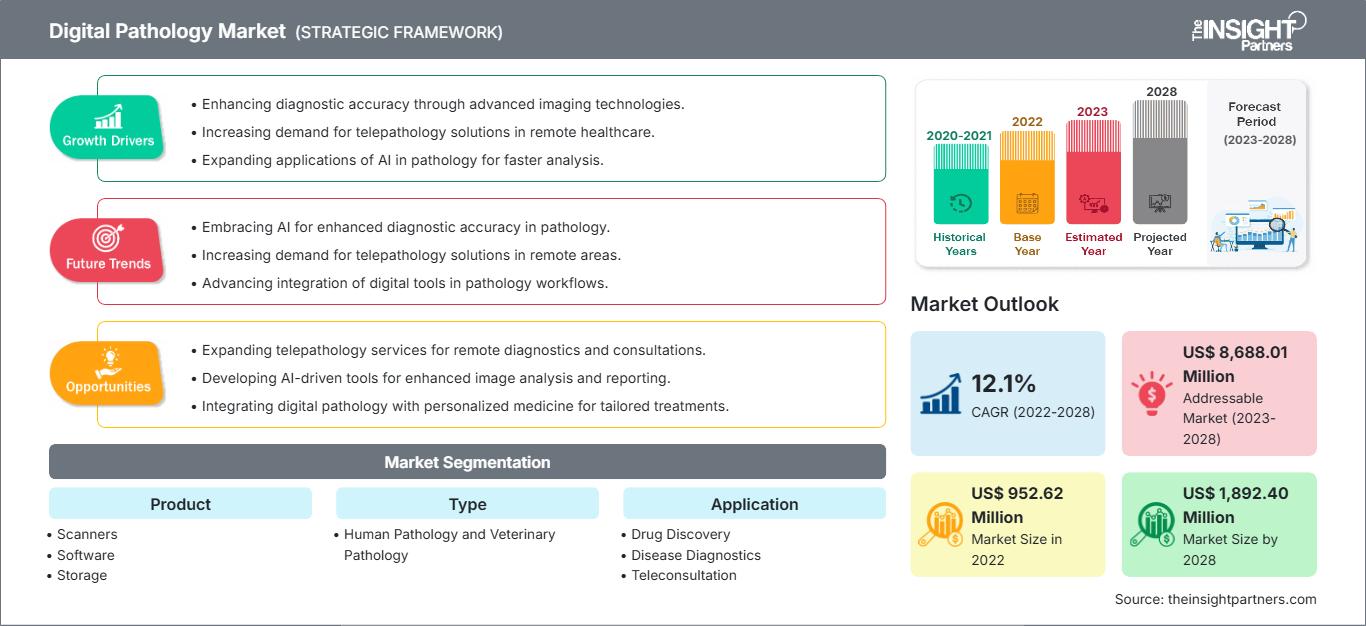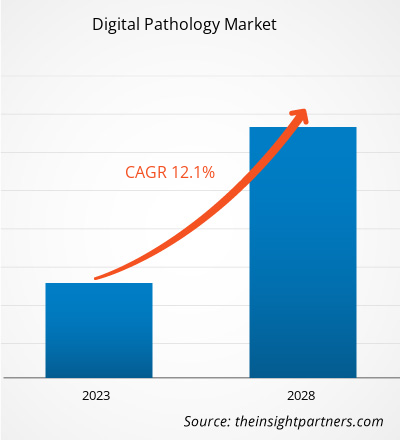[연구 보고서] 디지털 병리학 시장은 2022년 9억 5,262만 달러에서 2028년 18억 9,240만 달러로 성장할 것으로 예상되며, 2022년부터 2028년까지 연평균 성장률 12.1%로 성장할 것으로 예상됩니다.
시장 분석 및 분석가 의견:
디지털 병리학은 슬라이드 및 데이터를 포함한 병리학 정보를 디지털 환경에서 수집, 관리, 공유 및 해석하는 것을 포함합니다. 디지털 슬라이드 이미지 파일이 생성되어 디지털 병리학 슬라이드의 고해상도 보기, 해석 및 이미지 분석이 가능합니다. 디지털 병리학은 병리학자가 투명성과 일관성을 유지하면서 신속하고 원격으로 참여, 평가 및 협업할 수 있도록 지원하여 효율성과 생산성을 향상시킵니다. 디지털 병리학의 미래는 궁극적으로 향상된 중개 연구, 컴퓨터 보조 진단(CAD), 그리고 개인 맞춤형 의료를 포함할 것입니다. 디지털 병리학은 유리 슬라이드만으로는 쉽게 얻을 수 없는 분석 향상 및 오류 감소와 같은 이점을 제공합니다. 디지털 병리학의 중요한 이점 중 하나는 단기 및 장기적으로 생산성을 향상시키는 다양한 방법입니다.
성장 동력 및 과제:
정기 진단은 모든 암 치료의 첫 단계입니다. 기존 병리학 서비스로는 종양 세포의 위치만 파악할 수 있어 재검토를 위해 증례를 공유하기가 어렵습니다. 디지털 병리학을 활용하면 종양에 대한 심층적인 진단이 가능합니다. 암 진단을 위한 디지털 병리학 절차는 일반적으로 기존 유리 슬라이드를 스캔한 후, 연속적인 이미지를 디지털 방식으로 통합하여 유리 슬라이드의 정보를 복제하는 단일 이미지로 만듭니다. 이렇게 생성된 이미지는 관련 임상/병원 또는 검사실과 연계되어 병리학자에게 각 암 상태에 대한 통합된 정보를 제공합니다. 2017년 4월, 필립스는 미국 내 1차 진단용으로 필립스 인텔리사이트 병리학 솔루션을 판매할 수 있도록 FDA 승인을 받았습니다. 암 발생 건수가 지속적으로 증가함에 따라 검사의 복잡성과 횟수 또한 점점 더 증가하고 있습니다. 필립스 인텔리사이트 병리학 솔루션은 초고속 병리 슬라이드 스캐너를 비롯한 다양한 기능을 갖춘 이미지 생성, 보기 및 관리 시스템을 통해 자동화된 디지털 병리학을 지원합니다. 로슈(Roche)는 2021년 1월, 유방암 진단을 위한 uPath HER2 Dual ISH 이미지 분석 및 uPath HER2(4B5) 이미지 분석을 지원하는 CE-IVD 자동 디지털 병리학 알고리즘을 출시했습니다. 이 알고리즘은 의료 서비스 제공자가 각 환자에게 가장 적합한 치료 전략을 결정하는 데 도움을 줍니다. 인공지능은 이미지 분석 알고리즘에 활용되어 병리학자가 유방암을 빠르고 정확하게 진단할 수 있도록 지원합니다. 따라서 암 진단 분야의 기술 발전은 디지털 병리학 시장 성장을 촉진하고 있습니다.
이 보고서의 일부, 국가 수준 분석, Excel 데이터 팩을 포함하여 모든 보고서에 대한 사용자 정의를 무료로 받을 수 있을 뿐만 아니라 스타트업 및 대학을 위한 훌륭한 제안 및 할인을 이용할 수 있습니다
디지털 병리학 시장: 전략적 통찰력

-
이 보고서의 주요 주요 시장 동향을 확인하세요.이 무료 샘플에는 시장 동향부터 추정 및 예측에 이르기까지 데이터 분석이 포함됩니다.
보고서 세분화 및 범위:
“글로벌 디지털 병리학 시장”은 제품, 유형, 응용 분야, 최종 사용자 및 지역을 기준으로 세분화됩니다. 제품 기준으로 디지털 병리학 시장은 스캐너, 소프트웨어, 통신 시스템 및 스토리지로 세분화됩니다. 유형 기준으로 디지털 병리학 시장은 인간 병리학과 수의 병리학으로 나뉩니다. 응용 분야 기준으로 디지털 병리학 시장은 원격 진료, 질병 진단, 신약 개발 및 교육 훈련으로 세분화됩니다. 최종 사용자 기준으로 디지털 병리학 시장은 제약 및 바이오테크 기업, 병원 및 학계로 세분화됩니다. 디지털 병리학 시장은 지역별로 북미(미국, 캐나다, 멕시코), 유럽(독일, 프랑스, 이탈리아, 영국, 러시아, 기타 유럽), 아시아 태평양(호주, 중국, 일본, 인도, 한국, 기타 아시아 태평양), 중동 및 아프리카(남아프리카, 사우디아라비아, UAE, 기타 중동 및 아프리카), 중남미(브라질, 아르헨티나, 기타 중남미)로 구분됩니다.
세분화 분석:
제품별로 디지털 병리학 시장은 스캐너, 소프트웨어, 스토리지, 통신으로 구분됩니다. 스캐너 부문은 2021년 시장 점유율이 가장 높았으며, 예측 기간 동안 12.3%의 가장 높은 연평균 성장률을 기록할 것으로 예상됩니다. 스캐너는 빠르고 안정적이며 고해상도의 세포 이미지를 생성하는 데 도움이 됩니다. 병리학자, 조직학자 및 기타 의료 전문가들이 슬라이드를 스캔하고 이미지를 네트워크에 업로드하여 원격으로 접근하고 동료와 협업할 수 있도록 지원합니다. 이 스캐너는 세포 분석, 형광, 위상차, 투과광 보정을 위한 자동 세포 이미징을 제공합니다. 이러한 기술적 발전은 가상 슬라이드의 추가 분석, 편집, 관리 및 공유를 위한 통합 소프트웨어를 스캐너와 함께 제공합니다. 예를 들어, 2021년 4월, 선도적인 엔드투엔드 디지털 병리 솔루션 제공업체인 Optra Scan은 세계 최초의 저렴한 고속 디지털 병리 스캐너인 OS-ultra 320을 출시했습니다.
이 병리 이미징 시스템은 새로운 스캐너 기술과 소프트웨어를 사용하여 병리 검사 슬라이드를 디지털화합니다. 이는 기존의 슬라이드 및 현미경 병리 워크플로우를 대체합니다. 병리학자는 슬라이드를 디지털화하여 정밀 기기를 사용하여 병리 워크플로우의 고품질 디지털 사진을 검사할 수 있습니다. 이 시스템은 이미지를 컴퓨터에 저장하여 병리 워크플로우를 개선할 수 있습니다. 따라서 병리 영상 시스템 시장이 성장할 것으로 예상됩니다.
디지털 병리학 시장은 유형별로 인간 병리학과 수의 병리학으로 구분됩니다. 인간 병리학 분야는 2022년 65.94%의 시장 점유율로 가장 큰 비중을 차지할 것으로 예상되며, 예측 기간 동안 12.5%의 가장 높은 연평균 성장률을 기록할 것으로 예상됩니다. 인간 병리학 분야 성장의 주요 동인은 암 연구 활동의 증가와 연구소, 대학, 병리학 실험실 간의 협력 증대입니다. 인간 병리학은 인간 질병에 대한 임상병리학적 유의미성을 지닌 정보를 실험실과 임상 의사에게 제공하기 위해 고안되었습니다. 인간 병리학은 형태학적 및 임상 검사실 연구에서 추출된 정보를 의미하며, 인간 질병을 이해하는 데 직접적으로 적용될 수 있습니다. 진단 검사 및 치료 조언부터 최첨단 유전 기술 활용 및 질병 예방에 이르기까지 환자 치료의 모든 측면을 포괄합니다.
응용 분야별로 디지털 병리학 시장은 원격 진료, 질병 진단, 신약 개발, 교육 훈련으로 구분됩니다. 2021년에는 신약 개발 부문이 시장 점유율 1위를 차지할 것으로 예상되며, 향후 몇 년 동안 가장 빠른 속도로 성장할 것으로 예상됩니다. 디지털 병리학의 장점은 속도 향상과 정확한 결과 도출에 국한되지 않고, 병리학자들이 지리적으로 멀리 떨어진 곳뿐만 아니라 제약 및 생명공학 기업에도 전문 지식을 제공할 수 있도록 한다는 점입니다. 생명공학 및 제약 기업들은 전임상 연구에서 수천 장의 슬라이드를 검토하고 분석하는 데 어려움을 겪습니다. 디지털 병리학은 이미지 분석을 자동화하고, 방대한 양의 조직병리학 데이터에 즉각적이고 지능적인 접근을 제공하여 궁극적으로 신약 개발 프로세스를 가속화합니다. 기업의 연구원들은 인터넷에서 디지털 슬라이드를 볼 수 있어 현재의 단일 시야 이미지 보기 방식보다 크게 개선되었습니다. 최종 사용자를 기준으로 디지털 병리학 시장은 제약 및 생명공학 기업, 병원, 그리고 학계로 세분화됩니다. 제약 및 생명공학 기업의 2021년에는 디지털 병리학 부문이 시장 점유율 1위를 차지할 것으로 예상되지만, 재조합 백신 부문은 예측 기간 동안 시장 연평균 성장률 12.5%로 가장 높은 성장률을 기록할 것으로 예상됩니다. 제약 및 생명공학 기업들은 업무 관리를 디지털 방식으로 전환하고 있으며, 약물이나 치료법을 위한 분자 및 바이오마커를 지속적으로 발굴하고 있습니다. 디지털 병리학은 제약 회사와 R&D 연구소 간의 데이터 공유를 가능하게 하여 글로벌 제약 연구 혁신에 기여하고 있습니다. 이러한 기업들은 환자 상태를 기반으로 데이터를 수집하고 분석하여 약물을 평가합니다. 디지털 병리학 솔루션은 이러한 기업들이 기록을 유지하고 워크플로우를 효과적으로 관리할 수 있도록 지원합니다. 예를 들어, 애질런트 테크놀로지스, 제넨텍과 같은 기업들은 AI 기업과 협력하여 병리학 연구소의 디지털화 및 첨단 치료제 생산과 같은 프로세스를 업그레이드하고 있습니다.
지역 분석:
지리적 측면을 기준으로 디지털 병리학 시장은 북미, 유럽, 아시아 태평양, 남미 및 남미의 5개 주요 지역으로 나뉩니다. 중앙아메리카, 중동 및 아프리카. 북미 지역은 만성 질환 부담 증가, 만성 질환 관리 기술 도입 증가, 투자 증가, 제품 출시 증가, 그리고 시장 선도 기업들의 적극적인 추진으로 2021년 세계 시장에서 상당한 점유율을 차지할 것으로 예상됩니다. 미국은 예측 기간 동안 상당한 성장을 보일 것으로 예상됩니다. 암, 알츠하이머병 등 만성 질환 발병률 증가는 디지털 병리학 시장을 견인할 것으로 예상됩니다. 예를 들어, 미국 암 협회 2022 보고서는 2022년에 미국에서 약 236,740건의 새로운 폐암 사례가 진단될 것으로 추정했습니다. 같은 출처는 또한 2022년에 79,000건의 새로운 신장암 사례가 보고될 것이라고 말했습니다. 나아가, 2021년 12월 국제 당뇨병 연맹(IDF) 보고서는 2021년에 멕시코에서 1,400만 명의 성인이 당뇨병을 앓고 있다고 추정했습니다. 또한, 2021년 8월에 발표된 캐나다 정부의 보도 자료에 따르면 당뇨병은 캐나다인에게 영향을 미치는 주요 만성 질환으로, 2021년 8월 현재 300만 명이 넘는 캐나다인과 캐나다 성인의 6.1%가 당뇨병 발병 위험이 높았습니다. 암의 높은 부담은 디지털 병리학에 대한 수요를 촉진하여 시장 성장을 촉진할 것으로 예상됩니다. 유럽은 글로벌 세포 개발 시장에서 두 번째로 선도적인 지역입니다. 독일은 예측 기간 동안 유럽 디지털 병리학 시장에서 가장 큰 점유율을 차지하고 있습니다. 그 이유는 프랑스의 디지털 병리학 프로젝트, 교육 및 훈련 프로그램에 대한 지원 증가, 영국에서 암 유병률 증가 및 디지털 병리학 솔루션 도입, 독일에서 개최되는 컨퍼런스 수 증가와 같은 요인들이 유럽 디지털 병리학 시장 성장을 촉진할 가능성이 높기 때문입니다. 이러한 요인들은 유럽 디지털 병리학 시장 성장을 촉진하는 요인입니다.
디지털 병리학 시장 지역별 통찰력
The Insight Partners의 분석가들은 예측 기간 동안 디지털 병리학 시장에 영향을 미치는 지역별 동향과 요인을 면밀히 분석했습니다. 이 섹션에서는 북미, 유럽, 아시아 태평양, 중동 및 아프리카, 그리고 중남미 지역의 디지털 병리학 시장 세분화 및 지역별 분포도 살펴봅니다.
디지털 병리학 시장 보고서 범위
| 보고서 속성 | 세부 |
|---|---|
| 시장 규모 2022 | US$ 952.62 Million |
| 시장규모별 2028 | US$ 1,892.40 Million |
| 글로벌 CAGR (2022 - 2028) | 12.1% |
| 이전 데이터 | 2020-2021 |
| 예측 기간 | 2023-2028 |
| 다루는 세그먼트 |
By 제품
|
| 포함된 지역 및 국가 |
북미
|
| 시장 선도 기업 및 주요 회사 프로필 |
|
디지털 병리학 시장 참여자 밀도: 비즈니스 역학에 미치는 영향 이해
디지털 병리학 시장은 소비자 선호도 변화, 기술 발전, 그리고 제품 효능에 대한 인식 제고 등의 요인으로 인한 최종 사용자 수요 증가에 힘입어 빠르게 성장하고 있습니다. 수요가 증가함에 따라 기업들은 제품 및 서비스를 확장하고, 소비자 니즈를 충족하기 위한 혁신을 추진하며, 새로운 트렌드를 적극 활용하고 있으며, 이는 시장 성장을 더욱 가속화하고 있습니다.

- 을 얻으세요 디지털 병리학 시장 주요 주요 플레이어 개요
산업 개발 및 미래 기회:
글로벌 디지털 병리학 시장에서 활동하는 주요 업체가 취한 다양한 이니셔티브는 다음과 같습니다.
- 2022년 6월, SpIntellx, Inc.와 Inspirata는 SpIntellx HistoMapr-Breast 플랫폼과 Inspirata의 Dynamyx 소프트웨어를 완벽한 솔루션으로 통합하기 위해 협업했습니다. HistoMapr-Breast는 의료 서비스 제공자가 유방암을 보다 정확하고 효율적으로 진단, 예측 및 치료할 수 있도록 설명 가능한 인공 지능(xAI)의 힘을 활용하는 유일한 계산 병리학 소프트웨어입니다.
- 2022년 6월, Roche는 디지털 병리학을 위한 차세대 Ventana DP 600 슬라이드 스캐너의 CE-IVD 승인을 받았습니다.
- 2020년 5월, Danahar(Leica Biosystems)는 차세대 디지털 병리학 스캐너인 Aperio GT 450 DX를 아시아 태평양 지역에서 출시했습니다. 연속 로딩, 비접촉 작동, 40배 확대에서 32초 스캔 시간을 제공하는 Aperio GT 450 DX는 CE IVD 및 TGA에 등록되어 의료 기관이 디지털 병리학을 확장하여 품질을 저하시키지 않고 끊임없이 증가하는 요구 사항을 충족할 수 있도록 합니다.
- 2020년 7월, 3DHISTECH의 PANNORAMIC 스캐너 제품군의 핵심 제품인 PANNORAMIC 250 Flash III, PANNORAMIC Scan II 및 PANNORAMIC Midi II와 해당 제어 소프트웨어가 업그레이드되어 암 및 제약 연구, 분자 및 발달 조직학, 신경 과학 등의 다양한 요구 사항을 더욱 효과적으로 충족할 수 있게 되었습니다.
- 2020년 8월, 병리학 워크플로 솔루션 분야의 글로벌 리더인 Danahar(Leica Biosystems)는 Aperio GT 450 DX 디지털 병리학 스캐너의 유럽 출시를 발표했습니다. 이 차세대 영상 시스템은 매우 성공적인 Leica Biosystems Digital Pathology Virtual Summit에서 공개되었으며 이미 영국 Leeds Teaching Hospitals NHS Trust NHS의 Centre of Excellence에 설치되어 있습니다.
- 2020년 10월, Indica Labs는 HALO, HALO AI, HALO Link 및 HALO AP를 포함하여 National Cancer Institute(NCI) 내에서 Indica Labs 소프트웨어의 전사적 클라우드 기반 배포를 공식 출시한다고 발표했습니다. NCI 내 수백 명의 사용자가 액세스하고 수백만 개의 디지털 이미지를 관리하며 매일 수천 개의 이미지 분석을 용이하게 하는 것은 전 세계적으로 Indica Labs 소프트웨어의 가장 큰 단일 배포입니다.
- 2020년 5월, 병리학 워크플로 솔루션 분야의 글로벌 리더인 Danahar(Leica Biosystems)와 국제 의료 영상 IT 및 사이버 보안 회사인 Sectra는 미국 식품의약국(FDA)의 510(k) 승인을 공동으로 추진하기 위한 협업을 발표했습니다. 곧 미국 식품의약국(FDA)에 등록될 예정입니다. 통합 임상 디지털 병리 솔루션을 통해 학술 의료센터, 임상 연구 기관, 대형 병원 네트워크 등 기업 고객의 임상적 요구를 충족하는 것이 목표입니다.
경쟁 환경 및 주요 기업:
디지털 병리 분야의 대표적인 기업으로는 Koninklijke Philips NV, Nikon Corporation, Perkin Elmer, Inc., Indica Labs, 3DHISTECH Ltd., Danaher, Hamamatsu Photonics KK, F. HOFFMANN-LA ROCHE LTD., Visiopharm A/S, Glencoe Software, Inc 등이 있습니다. 이러한 기업들은 전 세계적으로 증가하는 소비자 수요를 충족하고 특수 포트폴리오의 제품군을 확대하기 위해 신제품 출시 및 지역 확장에 집중하고 있습니다. 전 세계적으로 광범위한 네트워크를 구축하여 다양한 고객에게 서비스를 제공하고 있으며, 이를 통해 디지털 병리 시장 점유율을 확대하고 있습니다.
- 과거 분석(2년), 기준 연도, CAGR을 포함한 예측(7년)
- PEST 및 SWOT 분석
- 시장 규모 가치/거래량 - 글로벌, 지역, 국가
- 산업 및 경쟁 환경
- Excel 데이터세트
최근 보고서
관련 보고서
사용 후기
구매 이유
- 정보에 기반한 의사 결정
- 시장 역학 이해
- 경쟁 분석
- 고객 인사이트
- 시장 예측
- 위험 완화
- 전략 기획
- 투자 타당성 분석
- 신흥 시장 파악
- 마케팅 전략 강화
- 운영 효율성 향상
- 규제 동향에 발맞춰 대응






















 무료 샘플 받기 - 디지털 병리학 시장
무료 샘플 받기 - 디지털 병리학 시장